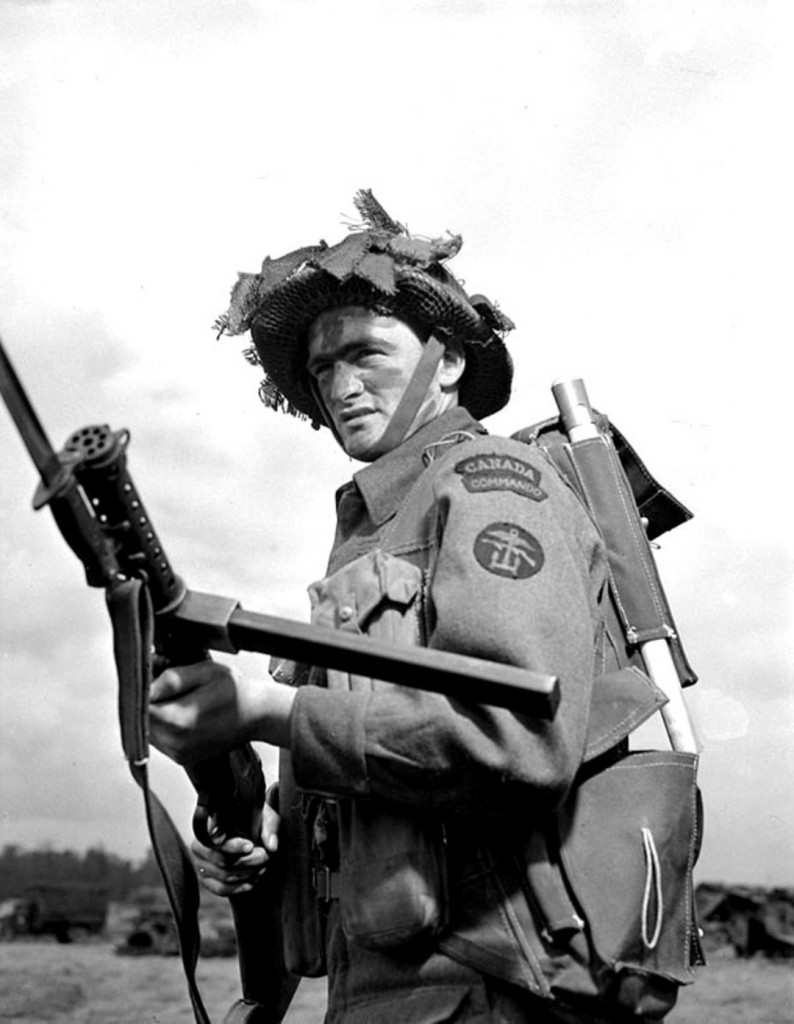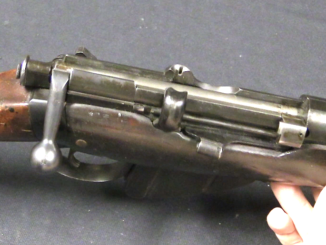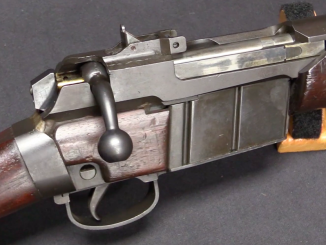
Canadian Commando with a Lanchester SMG. It wasn’t only the Japanese who put huge bayonets on subguns!
I do wonder how awkward it would get to use Lanchester mags, with their 50-round capacity. Notice the front pouches this fellow is wearing – they are a single continuous piece from the lid above his arm to the bottom of the pouch below it. In addition to putting a lot of of-center weight on an already-heavy gun (2.3 pounds of magazine in a 9.7 pound gun), I expect they also hindered movement and bending at the waist when stored in those pouches.




Ah, the Lanchster! A british copy of the MP28.
That’s probably Sten stayed at 32 rds capacity – sometimes plenty is a disadvantage, too. Later on the Lancs were given to less demanding jobs, including naval landing parties: there’s a photo of Polish naval ratings escorting the U-Boat survivors from ORP Burza destroyer ashore somewhere in England, 1943, shown there with Lanchesters and 50-rounders in place (though no bayos).
I meant to write “that’s probably WHY Sten stayed…”
The setup is pretty impractical. Canadians were said to treat long sword bayonets as nothing better than bread-toasting skewers, if I’m not mistaken. But at least that bayonet can serve as a way to deter rock-throwing mobs or North Korean hordes.
I’m not quite sure if a bayonet would serve as any sort of deterrent to a bunch of well-armed, hard-bitten North Korean soldiers, but I do get your point ( no pun intended ). Bayonets still have their offensive, defensive and utilitarian uses where applicable, as Big Al has implied. While the short length of a Lanchester SMG isn’t exactly the ideal back-up for a muzzle-end bayonet in terms of reach and leverage, it is still better than nothing as a hand-to-hand fighting implement. And the momentum it puts behind that bayonet, coupled with the thrust from the user’s body weight and muscular effort, should not be discounted either.
I’ll never understand fixing a chef’s knife to the end of a capable firearm.
I have a Mauser bayonet that would throw anyone’s aim off of any target.
Capable firearms do run out of ammunition.
And I’m led to believe that sometimes Commandos would like to attack an enemy without making a very, very loud noise…
To me, bayonet on SMG makes enough sense.
It’s ironic that as elegant as British sporting arms were, their military weapons were awkward and clumsily designed.
I’m in agreement with abacab here Hank, having used multiple marks of Lee-Enfield for target shooting and deer hunting, as well as having shot a Brown Bess, Snider-Enfield, and an Enfield No2 Mk1 revolver. as well as having handled Webleys, Browning Hi-Powers, and an slr762. British military arms are wonderfully ergonomic, especially compared to a lot of German weaponry; I will take an SMLE of any mark over a Kar 98K on any occasion I can conceive of.
Please point which of British “military weapons” you consider “awkward and clumsily”?
Most British weapons which I’m aware of are not awkward or clumsily, excluding STEN (but what you except from as cheap as possible sub-machine gun made in workshops which earlier don’t have any experience with fire-arms?)
Also: Notice that Pattern 1913 rifle was designed in Great Britian; Pattern 1913 rifle spawned Pattern 1914 rifle; Pattern 1914 rifle spawned M1917 Enfield, it was used even in Korean War as a sniper rifle, so I assume that it was not “awkard and clumsily” (snipers can choice himself their weapons). Also the M1917 Enfield spawned Remington Model 30 (sporting rifle) which were produced from 1921 to 1940.
“It’s ironic that as elegant as British sporting arms were, their military weapons were awkward and clumsily designed.”
I hereby challenge you to a mad minute. I’ll bring an SMLE or a No.4, you can bring any other military bolt-action rifle.
Anyway, SMLE and No.4 are excellent ergonomically. As is, surprisingly, the No.2 revolver.
And the BREN.
And then the ergonomic changes from the metric FAL to the SLR – a vast improvement.
The Lee rifles used by England were designed by a guy who lived in Milwaukee Wisconsin and the Bren was a Czech design.
The original action was Lee. Everything else about them it is pure RSAF.
James Paris Lee was born in Hawick, Scotland..
I am in general agreement about the ergonomic factors involving the Lee-Enfield bolt-action rifles. However, I have personally found little difference between the 7.62mm FAL and the L1A1 SLR in ergonomic terms, having used both extensively. Just my take on the subject at hand in the light of operational experience as to what works for me, of course. Other users might differ.
The main purpose of the bayonet on the business end of the SMG or assault rifle is weapon retention in house-clearing. The smart guy waiting to try to grab the barrel of your weapon as you come through the door gets a handful of razor-sharp steel blade instead. If you’re lucky, he ends up minus a few fingers.
Fun fact; the Lanchester was indeed a copy o the MP28. (The most noticeable differences are its brass magazine housing and the suspiciously SMLE-like shape of its buttstock.) It was manufactured by the Sterling Engineering Co., Ltd, for the Royal Navy, who used it until the early 1960s.
George Patchett, their design expert, was asked to come up with a “Sten-like” SMG that would be easily manufactured from stampings but have better reliability. His approacjh was basically to design a tamped-metal bersion of the Lanchester with a pistol grip amidship and a pantograph folding stock.
The resulting “Patchett Machine Carbine” apparently saw at least some action toward the end of WW2, and was used under that name by colonial police into the 1950s, notably in Kenya during the Mau Mau emergency. A semi-auto version was sold to “planters” in South Africa at the same time.
The Sterling SMG was the official name for the British Army version, the L1A1 and later variants. It’s interesting that one of the most-used SMGs of the last half of the 20th Century was a direct lineal descendant of the century’s first, the MP18/MP28.
cheers
eon
If I were waiting to disarm someone holding an assault rifle or a submachine gun, I wouldn’t grab the gun barrel from around a door frame. I’d just whack the guy with a conveniently placed large hammer once he got through the door. This would require that the intruder be literally in the dark, and would expose me to obvious danger.
Weapon of choice questionnaire:
Given a choice in clearing out an multistory office building occupied by terrorists, which would you take?
1. Lanchester or Sten
2. Steyr-Solothurn MP-34 (o)
3. Type 100 SMG or Type 99 LMG
4. MP-18, MP-28, or Erma EMP
5. Beretta MAB 38
6. Thompson M1923 with bipod and drum magazine
7. PPSH-41
8. M712 Schnellfeuer or Uzi
9. MG 18 TuF
10. Any combat shotgun
11. Any conveniently available melee weapons (including a katana, an axe, and a sledge hammer)
12. Let’s get the “bunkerknacker” halftrack or a flak-panzer to spray the place.
13. Screw all this and get 80cm Schwerer Gustav or any conveniently placed large railway gun!
14. Add your favorite toys to this list!
This questionnaire is for entertainment purposes only. You do not have to respond if you do not wish to do so. Please keep any criticism of this post humane.
“13. Screw all this and get 80cm Schwerer Gustav or any conveniently placed large railway gun!”
Railway artillery is for me overkill, 105mm field howitzer or 152mm howitzer is enough. 80cm Schwerer Gustav has too long setup-time to be practical. It needs too parallel tracks with constant distance which must be build before use. If you want to use railway artillery better get some what use single track like 28-cm-Kanone 5 (E).
“14. Add your favorite toys to this list!”
РПО «Шмель» flamethrower
http://en.wikipedia.org/wiki/RPO-A_Shmel
Which is actually disposable rocket-launcher firing rocket armed with thermobaric charge. Article in Russian wikipedia states that during use in Afghanistan they were nicknamed «Шайтан-труба» i.e. Pipe of Satan (or Trumpet of Satan)
106mm recoiless.
Are there hostage or civilians we are not supposed to kill?
If not and if we know they are not equipped for such situation, gas before assault could be useful (but illegal).
If we speak about controllability, a light carbine such as USM1/M2 could fit the role, and maybe MAS 38 that have the reputation of being very controllable. (with gazed baddies, I assume stopping power is less an issue when you can easily control a weapon with a better theoretical penetration)
50 round magazines and higher capacity seems good to stay shooting a while if needed, and the PPsH41 could be used to shoot through doors before to open it.
Wood st1ocked Uzi with an AimPoint red dot optic annnd a bayonette!
Oh, and a 75mm Recoilless modified to mount a bayonette, just to soften the target!
The Lanchester and Sterling were different SMGs manufactured by the same company.
Agreed. But the Sterling aka Patchett was based on the Lanchester/MP28 action, as any comparison of cutaways of the two side-by-side makes pretty obvious.
cheers
eon
“The main purpose of the bayonet on the business end of the SMG or assault rifle is weapon retention in house-clearing. The smart guy waiting to try to grab the barrel of your weapon as you come through the door gets a handful of razor-sharp steel blade instead. If you’re lucky, he ends up minus a few fingers.”
I would challenge that thought, actually, as the vast majority of bayonets were not sharpened by the factory and judged by what is available today as surplus they were mostly not sharpened by the troops either. The typical bayonet of the era was for stabbing, not for cutting.
Ah, the Sterling-Patchett 9mm SMG. I have fond memories of the Mk.V version — a nice, simple, compact, reliable SMG with excellent close-medium range firepower and accuracy, once you got used to the balance factor induced by the side-loading magazine. Thanks for bringing it up!
The Lancheater did use the Lee Enfield butt complete with recess under the butt stock plate for the oil bottle and pull through. Hence the similarity.
The long bayonet is the 1907 pattern used because there were a good few left in stock.
I once asked a former Parachute Regt officer why the Sterling SMG had a bayonet fitting – he pointed out that as it was used for close defence it made sense.
That fellow looks suspiciously clean for being in a ‘fix bayonets’ situation…
That fellow is Able Bodied Seaman Armand Therien from Montreal, a member of Royal Canadian Naval Beach Commando ‘W’. The Beach Commandos were specialized units tasked with expediting troop & vehicle movement on invasion beaches, sort of combination traffic cops, stevedores and perimeter defense force. ‘W’ was the last of 22 such units formed for D-Day, it spent 7 weeks operating on JUNO Beach after the invasion. Although naval forces , the BC were issued with British Army Battledress and equipment for their landlubbing role. Small Arms were a mix of No.4 Enfields, Lancaster SMG,.38 Revolvers, Brens & stripped down Lewis guns. The photo was probably posed at HMS Armadillo ( you gotta love English Ship & Shore base names )at Ardentinny on Loch Long Scotland. You keen of eye may have noticed that those Lancaster pouches are sewn directly onto the British 1942 pattern Battle Jerkin – talk about cumbersome! A group photo of ‘W’ on Juno shows a mix of Enfields, Lancasters and Lewis Guns, also a mix of Canadian, American and English Armored Troop helmets. My favorite comment on the Lancaster comes from Ian Hogg who declared that the brass magazine housing offered a quant naval touch.
I have always found that British military weapons that had peace time development cycles tended to be pretty good firearms. As witness the BREN ,the Sterling SMG (tinkered with for years after WWII)and the Enfield rifles. When you get a “hurry up” job like the STEN, you might still get a useable weapon but without the refinement process or elimination of problems that takes place in the more relaxed pace of peacetime development.
Agreed — a good summary on your part, I think.
There’s a practical reason to have a sideway feeding magazine if you have to put your belly to the dirt; but 50 rounds? Did they have magic wound spring steel back then?
Having “witnessed” vertical assaults (top-down with a “reception committee” waiting on the ground) assaults on occupied buildings once or twice in the past, next time I would choose either the M114 or M198 155 mm howitzer firing a W48 round. It’s not very sporting but much safer.
“You win! By DEMOLITION!!!!” If there were no hostages, that’s probably what I would do too. I suppose however that I ought to give you guys a PzB-39 or a Lahti AT rifle for sniping through any broken windows if there were hostages.
Most Honorable Mr. Cherndog:
It is with deepest remorse, regret and shame that I must return my treasured Blue Ribbon along with my sincerest apologies: I forgot that neither of these weapons has a bayonet lug and therefore must be disqualified for consideration in the pending competition.
Respectfully submitted,
Bill B
Oops. Totally forgot about that. I think I’ll leave you the consolation prize: a ZH-29 with a 20 round magazine and bayonet. Good luck!
Many thanks. You are most gracious!
Patricia Velazquez playing the Mummy’s girlfriend used one in “The Mummy Returns”. I’m sure it was a stand-in for an MP-28.
There’s nothing like a sexy woman with a submachine gun! 🙂
Amen!! Now to convince my wife to hold the Uzi for me…
A Lanchester was used by an old lady of the town and later by one of the Fuzz in the very funny film “Hot Fuzz”.
The side-mounted magazine made the Sterling, AKA Smudge Gun or Small Metal Gun, surprisingly good when folded for concealed carry under a coat.